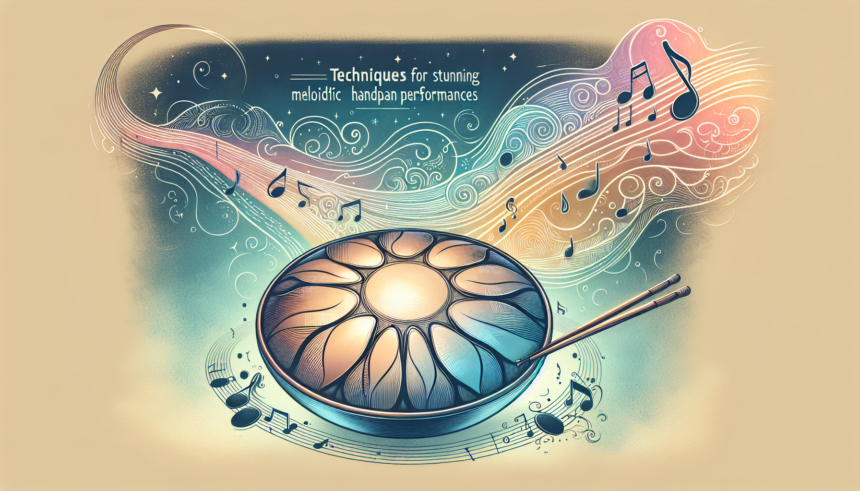Techniques for Stunning Melodic Handpan Performances
The handpan is a melodic percussion instrument that has been gaining popularity among musicians and enthusiasts alike. Its unique sound and meditative qualities make it a favorite for both solo and ensemble performances. To ensure your handpan performances are truly stunning, mastering various techniques is essential. In this article, we will explore various techniques that can elevate your handpan playing to the next level.
Understanding the Basics
Before diving into advanced techniques, it’s imperative to have a firm grasp of the basics. Understanding the layout of your handpan, the scale it’s tuned to, and the proper hand techniques are the foundation upon which all other skills are built.
Proper Hand Technique
- Finger Pads and Fingertips: Using the pads of your fingers and sometimes the tips can produce a softer, more resonant sound.
- Slap Technique: Utilizing a quick, sharp motion with the fingers creates a percussive and more emphatic note.
- Thumb Strokes: Thumbs are often used to strike the central note or ding, but can also be employed for side notes, creating varied tones.
Rhythmic Patterns
Mastering rhythm and timing is crucial for any musician. Develop a solid understanding of rhythmic structures and practice with a metronome to ensure you maintain consistent timing. Experiment with different time signatures and syncopations to add interest and complexity to your performances.
Dynamic Control
Playing with dynamics involves varying the intensity and volume of your playing. This adds expression and emotional depth to your performances. Practice playing softly and gradually building up to louder sections, or vice versa, to develop sensitive dynamic control.
Techniques for Expressive Playing
- Muting: Gently but quickly touching a note after striking it can mute the sound, allowing for rhythmic variation and a staccato effect.
- Glissando: Sliding your fingers across the surface can create a fluid motion between notes, adding a sense of movement and connection.
- Harmonics: Lightly touching a node point on the handpan while striking the note can produce harmonic overtones, adding richness and complexity to the sound.
Exploring Different Playing Styles
Your handpan can be played in a variety of styles, each offering a distinct musical experience.
Melodic Playing
This style focuses on creating flowing, melodic lines. Practice scales, arpeggios, and simple melodies to develop your melodic capabilities.
Rhythmic Playing
Emphasizing percussive elements, rhythmic playing can make your performance more dynamic and engaging. Integrate drumming techniques and syncopated rhythms to add energy and drive.
Ambient Playing
Slower, more meditative playing emphasizes the ethereal qualities of the handpan. Focus on long, resonant notes and spacious, open timing to create a peaceful soundscape.
Incorporating Other Instruments
Combining the handpan with other instruments, such as drums, flutes, or string instruments, can enhance your performance. The handpan’s harmonic richness blends beautifully with many other instruments, allowing for endless creative possibilities.
Using Electronics and Effects
Exploring the use of electronics and effects pedals can expand your handpan’s sound palette. Reverb, delay, and looping pedals can add depth and texture, creating a more immersive listening experience.
Practice and Improvisation
Regular practice is key to honing your skills. Set aside dedicated practice time to work on scales, techniques, and specific pieces. Additionally, improvisation is a powerful tool for developing creativity and spontaneity in your playing. Allow yourself to explore freely and discover new ideas.
Recording and Performance Tips
When recording or performing live, take advantage of good-quality microphones to capture the full range of your handpan’s sound. Being mindful of acoustics and mic placement can make a significant difference in the quality of the recording or live sound.
Conclusion
Mastering the handpan involves a blend of technical proficiency, rhythmic understanding, and creative expression. By exploring various techniques and playing styles, you can elevate your performances and captivate your audience. Stay curious, keep experimenting, and most importantly, enjoy the journey of making beautiful music with this unique instrument.
FAQs
- 1. What is the best way to start learning the handpan?
- Start by understanding the basic layout and scale of your handpan. Focus on developing proper hand techniques and simple rhythms before moving on to more complex patterns.
- 2. How often should I practice to improve my handpan skills?
- Consistency is key. Aim for regular practice sessions, even if they are short. A daily practice routine of 15-30 minutes can be very effective for skill development.
- 3. Can I use a handpan with other musical instruments?
- Absolutely, the handpan harmonizes well with many other instruments. Experiment with combining it with drums, flutes, guitars, or any other instrument to create rich and diverse musical pieces.
- 4. What are the common mistakes to avoid while playing the handpan?
- Avoid striking the handpan too hard, as it can damage the instrument and produce an unpleasant sound. Also, be mindful of your posture and hand positioning to prevent strain and ensure optimal sound production.
- 5. Are there online resources available for learning the handpan?
- Yes, there are many online tutorials, video lessons, and forums where you can learn more about handpan techniques and connect with other players. Platforms like YouTube and specialized handpan websites can be very helpful.





